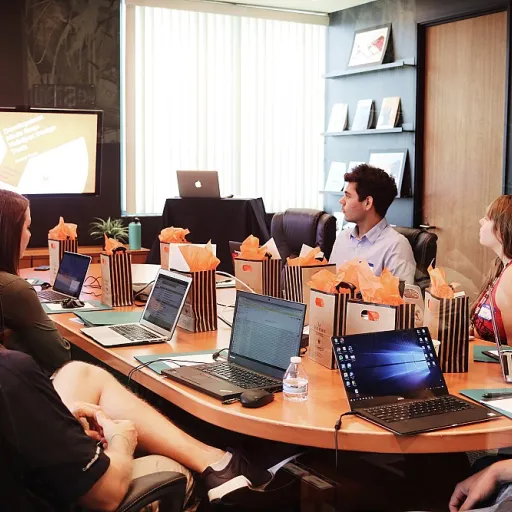
Understanding the Core of a Business Case
Defining the Essence of a Business Case
At the heart of any successful strategic initiative lies a well-crafted business case. This document serves as a cornerstone, providing a structured approach to decision-making and ensuring that all stakeholders are aligned with the overarching goals. A business case is not just a formality; it is a vital tool that helps institutions, especially those dealing with complex systems like ERP SIS and centralized application processes, to articulate the value of their strategic initiatives.
When developing a business case, it is crucial to consider the unique needs of your organization. Whether you are managing applicant data through a businesscas application or navigating the intricacies of international student enrollment, the business case should address these specific challenges. It should provide a clear pathway for how the proposed strategies will enhance the institution's capabilities, from improving data CRM systems to optimizing the export manager functions.
Incorporating data-driven insights is essential. By leveraging cas data and other relevant metrics, you can create a compelling narrative that highlights the potential benefits of the proposed initiatives. This is particularly important for institutions that rely on systems like webadmit and sis erp to streamline their application processes and make informed admissions decisions.
For those navigating the complexities of strategic advisory, especially in dynamic environments like Paris, understanding the core of a business case is fundamental. It sets the stage for aligning business objectives with strategic goals, ensuring that every step taken is purposeful and directed towards achieving long-term success. For more insights on navigating these complexities, consider exploring navigating the complexities of strategic advisory in Paris.
Aligning Business Objectives with Strategic Goals
Align Business Goals with Strategic Ambitions
A well-crafted business case requires more than just numbers. It demands a meticulous alignment of business objectives with the overarching strategic goals of the company. This ensures that efforts and resources are directed towards the same destination, promoting coherence and reducing the risk of fragmented strategies. Understanding the needs of various stakeholders is crucial. For institutions relying on systems like ERP and SIS, the businesscas application should reflect the strategic priorities embedded within these platforms. For instance, when engaging with international students or managing applicant data, the application process should align with broader goals of increasing enrollment and diversifying the applicant pool. Institutions can harness programs like WebAdMIT and centralized application services (CAS) to streamline these processes, ensuring they are not just efficient but also strategically sound. Additionally, aligning business objectives with strategic goals involves consistent monitoring and assessment of data. Using CAS data and SIS ERP systems can provide insights into applicant trends and export manager requirements, allowing for informed decision-making that supports strategic goals. By leveraging ERP SIS capabilities, organizations can import CAS data seamlessly, aligning it with the data CRM or other businesscas programs. Ultimately, aligning business objectives with strategic goals is about weaving together multiple programs and services to create a seamless strategic tapestry. By doing so, institutions will provide clarity to liaise with stakeholders effectively, ensuring that every aspect of the businesscas will support the larger mission. For further insights, consider exploring how crafting compelling narratives in corporate strategy can enhance this alignment here. With a clear understanding of this alignment, the next step often involves a deeper dive into financial justification and ROI analysis, ensuring that strategic investments deliver tangible value.Financial Justification and ROI Analysis
Financial Evaluation and Return on Investment (ROI)
A comprehensive business case requires meticulous financial analysis to ensure that strategic initiatives deliver substantial returns. Evaluating the financial justification revolves around understanding the potential of initiatives and how they align with your financial objectives. By integrating data-driven insights from tools like ERP SIS and CRM systems, institutions can better predict financial outcomes and tailor strategies accordingly. In a practical sense, developing a businesscas application that handles applicant data and centralizes the application process for multiple programs can exemplify this. Institutions benefit by reducing redundant processes, optimizing applicant management, and improving enrollment through improved CAS data integration.- Revenue Potential: Understand how each initiative could potentially boost revenue. For instance, seamless integration of admissions decisions with ERP systems not only streamlines operations but may also attract more international students, thereby expanding your revenue base.
- Cost Analysis: Assess the costs involved, including system implementation costs, like those for SIS ERP and liaison applications. Evaluating upfront investments versus long-term gains is crucial to determining your ROI.
- ROI Assessment: Calculate the ROI over a realistic timeline. ROI isn't solely about immediate financial return; consider the broader operational efficiencies, such as reduced data sis processing time and enhanced export manager capabilities through data crm.
Risk Assessment and Mitigation Strategies
Evaluating Potential Hazards and Developing Contingency Plans
Risk assessment and mitigation are pivotal components when crafting a compelling business case. As strategies align with business objectives and financial justifications come into play, identifying potential risks becomes crucial for avoiding unexpected pitfalls. To effectively assess risks, consider the following strategies:- Comprehensive Data Analysis: Evaluate applicant data, enrollment trends, program participation, and cas data from centralized application systems and crm sis tools. This helps pinpoint vulnerabilities within the application process and identify potential disruptions affecting international students and institutions.
- Engage Technology and Systems: Leverage SIS ERP and ERP SIS systems to import CAS and manage data more effectively. These systems provide the necessary infrastructure support and data CRM insights, allowing for robust risk monitoring and mitigation.
- Scenarios and Contingency Planning: Develop scenarios that address potential application process disruptions, admissions decisions delays, or export manager inconsistencies. Establish contingency plans for each scenario to minimize risks. For instance, a thorough export plan ensures that international programs and businessCAS application details are consistently aligned with institutional standards.
- Stakeholder Engagement: Proactively involve stakeholders in discussion about potential risks and mitigation strategies. Engaging faculty, staff, and liaison teams early can lead to efficient problem-solving and build confidence in the businesscas account management.
Engaging Stakeholders and Building Consensus
Building Consensus Through Stakeholder Engagement
Crafting an effective business case requires a collaborative approach to engage stakeholders and build consensus. In the interconnected world of strategic planning, it is critical to align various parties from different levels of the organization and beyond. Truly engaging stakeholders can transform a business case from a mere document into a shared vision of success.- Connect Early: Initiating conversations with key stakeholders early in the businesscas process helps set the tone for future collaboration. Whether it's departments involved in admissions decisions or technology partners leveraging systems like SIS ERP or CAS data, early engagement fosters transparency.
- Identify Key Players: Identify which stakeholders are essential for your businesscas success. This includes internal teams like the CRM SIS unit, as well as external partners like export managers or decentralized application vendors.
- Communicate Clearly: Use clear and consistent messaging when discussing the application and implementation of your business strategy. Avoid jargon and focus on what is relevant to each stakeholder segment. For instance, when discussing ERP systems, focus on the benefits to international students and institutions.
- Utilize Data: Providing stakeholders with relevant data, such as applicant data or ece enrollment metrics, enhances credibility and forms the backbone of your argument for change. Demonstrating potential for ROI can be pivotal in rallying support.
- Address Concerns: Be proactive in addressing concerns and opposition from any stakeholders. Facilitate open discussions about risk assessment and how your proposed programs will provide solutions.
- Build Trust: Trust is the cornerstone of stakeholder engagement. By consistently delivering accurate data and demonstrating a commitment to shared goals, businesscas applications gain credibility. Trust-building is crucial for consensus and long-term success.
Measuring Success and Continuous Improvement
Tracking Progress and Adapting Strategies
Measuring success in your business case is not just about ticking boxes; it's about ensuring that your strategic objectives are met and that your organization continues to thrive. To achieve this, institutions must establish clear metrics and benchmarks that align with their strategic goals. This involves leveraging data from various systems such as ERP, SIS, and CRM to gain insights into the effectiveness of your initiatives.
Consider the following steps to ensure continuous improvement:
- Define Key Performance Indicators (KPIs): Establish KPIs that are directly linked to your strategic objectives. These could include metrics related to enrollment numbers, applicant data, or the efficiency of the application process.
- Utilize Data Analytics: Use data from your centralized application systems, such as CAS and WebAdmit, to monitor trends and make informed decisions. This data can provide valuable insights into applicant behavior and program effectiveness.
- Regularly Review and Adjust: Schedule regular reviews of your business case to assess progress. This involves analyzing data from ERP and SIS systems to identify areas for improvement and adjust strategies accordingly.
- Engage Stakeholders: Keep stakeholders informed and involved in the process. Their feedback can provide valuable insights and help build consensus for any necessary changes.
- Focus on Continuous Learning: Encourage a culture of continuous learning and adaptation. This will ensure that your organization remains agile and responsive to changes in the market and the needs of international students and other applicants.
By implementing these strategies, your business case will not only achieve its initial goals but also adapt to new challenges and opportunities, ensuring long-term success.














